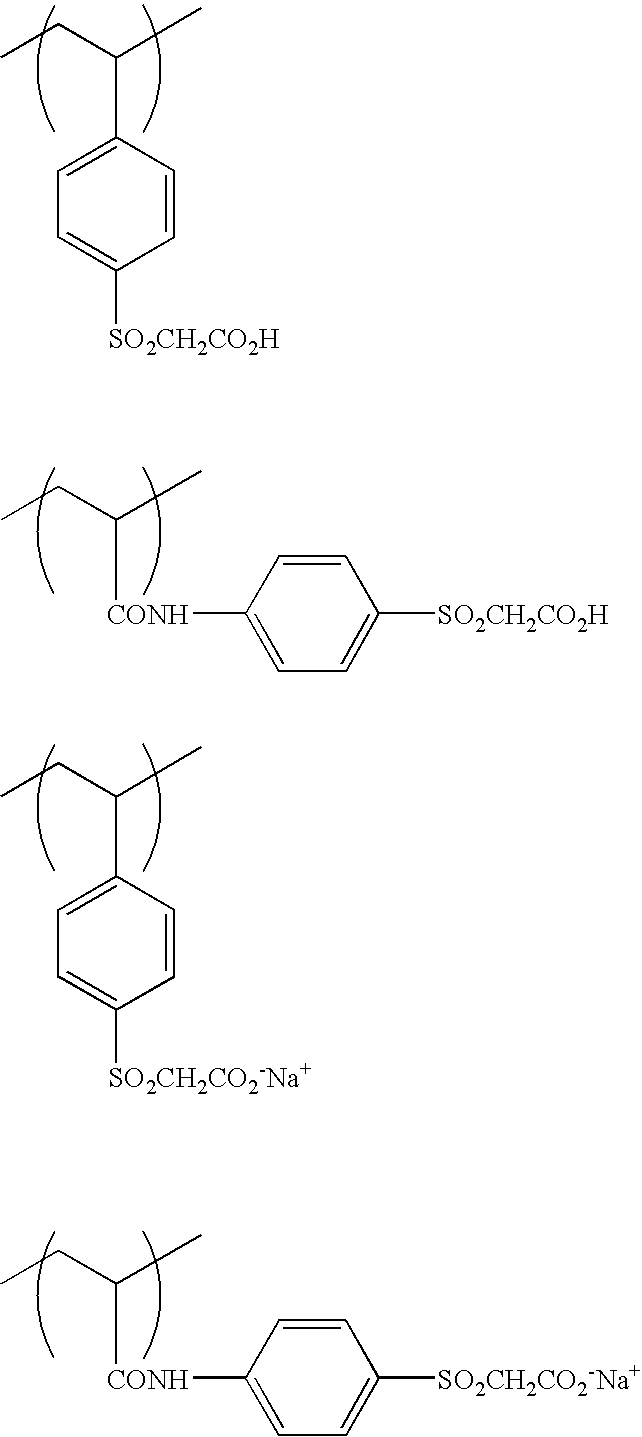Polymerizable composition, hydrophilic film using it and planographic printing plate precursor
- Summary
- Abstract
- Description
- Claims
- Application Information
AI Technical Summary
Benefits of technology
Problems solved by technology
Method used
Image
Examples
synthesis example 1
Synthesis of Amide Macromonomer
[0171] 30 g of acryl amide and 3.8 g of 3-mercapto propionic acid were dissolved in 70 g of ethanol, the temperature was increased to 60° C. in a nitrogen atmosphere, and 300 mg of a thermal polymerization initiator, 2,2-azobisisobutylnitrile (AIBN), was added thereto followed by reacting for 6 hours. After the reaction, the white precipitates were filtered and washed thoroughly with methanol to obtain 30.8 g of terminal carboxylic acid prepolymer (acid value: 0.787 meq / g, molecular weight: 1.29×103). 20 g of the obtained prepolymer was dissolved in 62 g of dimethylsulfoxide, and 6.71 g of glycidylmethacrylate, 504 mg of N,N-dimethyldodecylamine (catalyst) and 62.4 mg of hydroquinone (polymerization inhibitor) were added thereto followed by reacting at 140° C. for 7 hours in a nitrogen atmosphere. The reaction solution was added to acetone to precipitate a polymer, and washed sufficiently to obtain 23.4 g of a terminal methacrylate acrylamide macromon...
synthesis example 2
Synthesis of Sulfonic Acid Macromonomers
[0172] 147.8 g of methacrylic acid 3-sulfopropylester potassium salt, 3.82 g of mercapto propionic acid and 0.582 g of polymerization initiator, VA-044, manufactured by Wako Pure Chemical Industries Ltd. were dissolved in 151.5 g of water, and the obtained aqueous solution was added dropwise to 151.5 g of water maintained at 50° C. for 2 hours in a nitrogen atmosphere. After dropwise addition, the solution was stirred at 50° C. for 2 hours and at 60° C. for 2 hours, and was cooled followed by slow dropwise addition to 4.5 L of acetone to precipitate a white solid product.
[0173] The obtained solid product was filtered, and dried to obtain 145 g of polymer A. The acid value was 0.086 meq / g after drying.
[0174] 80 g of polymer A was dissolved in 240 g of acetone / water (½ by volume) solvent, and 6.17 g of α-bromomethylmethacrylate and 3.48 g of triethylamine were added thereto, followed by stirring at room temperature for 10 hours, further follo...
example 1
Hydrophilic Film
[0175] The coating liquid for forming a hydrophilic film having a composition shown below was coated on a glass plate (Endo Scientific Instrument Co., Ltd.), which is a substrate (support), to obtain a dry coated amount of 2 g / m2, and was heat-dried at 120° C. for 2 minutes to form the hydrophilic film on the substrate.
[0176]
Sulfonic acid macromonomer (above)4gEthoxylated trimethylolpropane acrylate4g(Nippon Kayaku Co., Ltd., SR-9035)IRGACURE 2959 (Ciba Specialty Chemicals)0.5gWater100g
Curing of the Hydrophilic Film
[0177] The substrate having a hydrophilic film was put into a vat, and the top surface was sealed with FORWRAP (manufactured by Riken Technos Corp.) and the air was substituted by nitrogen, and exposure was carried out for 10 minutes using a 400 w high-pressure mercury lamp (manufactured by Rico Kagaku Sangyo Co., Ltd., UVL-400P). The obtained substrate having a hydrophilic cured film was dipped in ion exchange water for 1 minute and was dried at 110°...
PUM
| Property | Measurement | Unit |
|---|---|---|
| Hydrophilicity | aaaaa | aaaaa |
Abstract
Description
Claims
Application Information
 Login to View More
Login to View More - R&D
- Intellectual Property
- Life Sciences
- Materials
- Tech Scout
- Unparalleled Data Quality
- Higher Quality Content
- 60% Fewer Hallucinations
Browse by: Latest US Patents, China's latest patents, Technical Efficacy Thesaurus, Application Domain, Technology Topic, Popular Technical Reports.
© 2025 PatSnap. All rights reserved.Legal|Privacy policy|Modern Slavery Act Transparency Statement|Sitemap|About US| Contact US: help@patsnap.com



